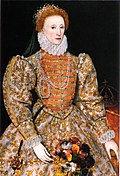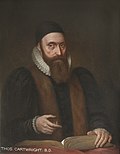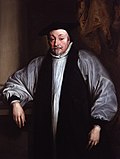Elizabethan Religious Settlement
The Elizabethan Religious Settlement was Elizabeth I’s answer to the religious quarrels that developed during the reigns of Henry VIII, Edward VI and Mary I.
This answer was given in two Acts of the Parliament of England. The Act of Supremacy of 1559 confirmed the English church’s independence from Rome. The Act of Uniformity 1559 decided about the form of the English church.
Often it was seen as the end of the English Reformation and the foundation of Anglicanism. But some historians think that England only became a Protestant nation on a popular level many years later. There seem to have been great divisions in the population and among the clergy for a long time afterwards.
Elizabethan Religious Settlement Media
- The "Darnley Portrait" of Elizabeth I of England. It was named after a previous owner. Probably painted from life, this portrait is the source of the face pattern called "The Mask of Youth" which would be used for authorized portraits of Elizabeth for decades to come. Recent research has shown the colours have faded. The oranges and browns would have been crimson red in Elizabeth's time.
Queen Elizabeth I opening Parliament
Thomas Cranmer (1489–1556), Edward VI's Archbishop of Canterbury and editor and co-author of both the 1549 and 1552 Books of Common Prayer.
Ancient altar stone at Jacobstow Church. It was the main altar stone up to about 1550 in the reign of Edward VI when it was removed and used as a footbridge over a stream.
A 17th-century communion table in St Laurence Church, Shotteswell
Related pages
Other websites
- The Legacy of the Reformation: A New Approach Archived 2008-01-21 at the Wayback Machine
- Queen Elizabeth I (1533-1603), Elizabethan Religious Settlement[dead link]
- Elizabeth's Act of Uniformity (1559)
- Documents Illustrative of English Church History








